A study in which scientists combined findings from the field mapping of the Les Avellanes salt diapir in the Pyrenees and laboratory modelling of its formation.
Geodynamic processes take place on a large scale and happen over a very long time. „We gain a better understanding of the geodynamic processes through the analog modeling in laboratory,” says Prokop Závada from the Dynamics of orogen and rock deformation group, and adds: “We were interested in the influence of the so-called ‘stringers’ embedded in the original salt layer on the spreading of salt mass over the surface.”
A salt diapir is a geological structure that is formed by the displacement of salts from the underlying layers towards the surface, due to their lower density compared to the overlying rocks. Stringers are pieces of other sedimentary rocks encased in salt deposits. Compared to salts, they are less ductile and they tear and fold inside the salt mass. „Their arrangement on the surface reflects the way the salt mass is transported and deformed inside the diapir body and later flows over the Earth’s surface,” says Ondřej Krýza from the GFÚ.
Gabriel Cofrade Rivas, the first author of the publication, is a PhD student in the group focused on salt tectonics and modelling (Geomodels Research Institute, University of Barcelona, Spain). Last year he performed experiments in the Tectonic modelling laboratory at GFÚ and we are very happy about this fruitful collaboration.

Cross-section of the salt diapir analogue model
Publication
Gabriel Cofrade, Prokop Závada, Ondřej Krýza, Irene Cantarero, Òscar Gratacós, Oriol Ferrer, Sadegh Adineh, Pedro Ramirez-Perez, Eduard Roca, Anna Travé, The kinematics of a salt sheet recorded in an array of distorted intrasalt stringers (Les Avellanes Diapir – South-Central Pyrenees), Journal of Structural Geology, 11 (2023), DOI: https://doi.org/10.1016/j.jsg.2023.104963

